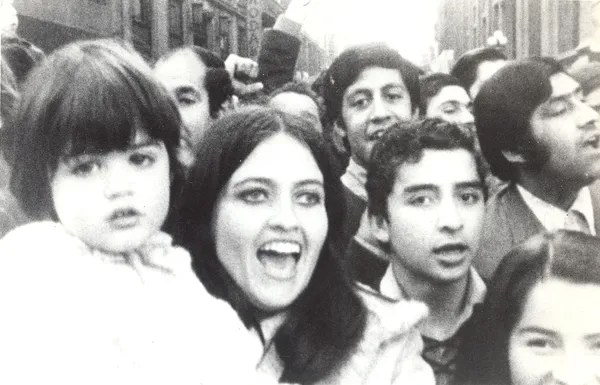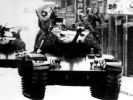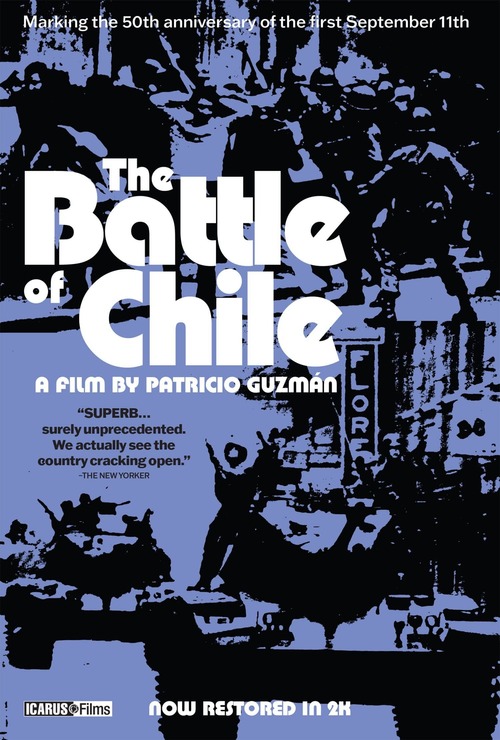Eye For Film >> Movies >> The Battle Of Chile (1979) Film Review
The Battle Of Chile
Reviewed by: Jennie Kermode

There is a myth that when societies collapse into fascism, nobody sees it coming. The reality, more often than not, is that practically everybody sees it coming but ordinary citizens – and many in positions of influence – feel helpless to stop it. In Chile in 1973, when the country stood on the brink, one small group of filmmakers, led by Patricio Guzmán, set out to make a documentary which, if it could not turn the tide, could at least capture and preserve the truth. The result was the three part Battle Of Chile, which has recently been subject to a painstaking process of restoration and is about to return to cinemas to reach out to a new audience.
They did so at considerable risk. Cinematographer Jorge Hernán Müller Silva would eventually be arrested by the Pinochet regime, joining the ranks of the disappeared. The rest of the team would have to flee the country. They wouldn’t even have been able to do what they did without the support of French filmmaker Chris Marker, who sent them film stock which subsequently had to be smuggled out again. They were all in their twenties and thirties and not particularly experienced, but the advantage of that was that nobody knew their faces, and between this and their sheer bravado, they managed to gather some extraordinary footage of events as they unfolded.

The film is very much centred on the ordinary people of Chile, so it’s fitting that it begins with the filmmakers pressed into the throng as people fill the streets in political protest. By simply walking up to random strangers and asking for their views, they collect an impressive amount of testimony. This was still a point in history at which people confronted with cameras felt that it was their duty to be honest. Not everyone marching plans to vote for the same people, but their sentiments are similar, and the general feeling is that Salvador Allende and Popular Unity will tally at least 40% in the coming election – enough to keep them in office. The mood is upbeat.
Away from the marches, the filmmakers ask the same questions of people in cars. Here the answers are move varied. When they approach people in suits, they find Allende a lot less popular. Unprompted, a woman in the middle of such a throng suddenly starts shouting about how Communists should be forced out of Chile, calling them filthy and degenerate, proclaiming her enthusiasm for the pure and clean government which will replace them. The ferocity of her tirade is a chilling harbinger of things to come.
The remainder of Part One deals with the political events which followed, the difficulties of the economic situation facing ordinary people, and the gradual escalation of anti-democratic action. In that opening scene, Guzmán’s team also asks people if they are in favour of elections; the vast majority, regardless of their voting intentions, say yes. We will see this gradually change until, at the end of Part Two, the generals’ claim that they were mandated to overrule democracy because the state had ‘lost its qualities’ is all too easily accepted. Part of the power of the film is that it is so much a product of Chilean insiders, caught up in this madness themselves, that it contains no benchmark against which a viewer can measure what is happening.
Extraordinary events occur but it’s easy to perceive them as inevitable. Only the occasional little flash of wit – a glance at a cinema poster for Sergio Solima’s Violent City as fights break out in the streets – serves to undermine those easy fascist narratives of doom and destiny. In the meantime, Guzmán shows a keen eye for how things break down. People who struggled to access supplies during the first months of the Covid pandemic will be amused to see that black marketeers have prioritised toilet paper alongside flour and rice. Claims about US involvement in supporting Allende’s opponents were controversial when this film was first released, but declassified documents now support them.
Part Two deals with the coup itself. Here the focus on ordinary people remains, but there is also an impressive amount of footage of key military and political figures. Guzmán’s team shows an uncanny knack for being in the right place at the right time. They capture Allende himself in various formal contexts and in conversation with ordinary people, to whom he defends his peaceful, democratic strategy in contrast to the more militant route which they feel the circumstances justify. They reveal Augusto Pinochet, a world away from the brazen tough guy image which he would later seek to present to the world, sneaking to and fro, lurking on the edge of events for some time before gradually moving himself towards the centre. They show us the tanks in the streets, the explosions as army factions fight one another. There is footage captured by an Argentinean journalist as he is deliberately shot to death by a soldier.
Other key political figures, including some who would later try to deny their involvement in the purges which followed, are identified as they emerge and become part of the process, in which parliamentary activity gradually gives way to military action. We see Catholic priests holding their Masses for Peace, hear from parents discussing the future they want for their children, and see the shelling of La Moneda. We are in the room with the generals when they make their monstrous speeches, and later we see soldiers rounding up people who resist in rural areas. It’s an astonishing achievement from a crew who barely had a budget, never mind the risk they were running.
Part three offers not so much a continuance of events as a reflection on what has passed, looked at from a different angle. Here Guzmán steps back from the headline-makers to learn more about what civic organisations were doing whilst all this took place, and to meet some of those who planned to continue their struggle no matter what the future brought. There is a sense that they accepted what would happen long before it did, not resigning themselves to it so much as building their courage and preparing to start again.
An extraordinary piece of work, The Battle of Chile is one of the greatest achievements in documentary to date, and an invaluable contribution to the historical archives. It’s also a deeply absorbing watch. Don’t miss the chance to catch it on a big screen if you can.
Reviewed on: 07 Sep 2023















